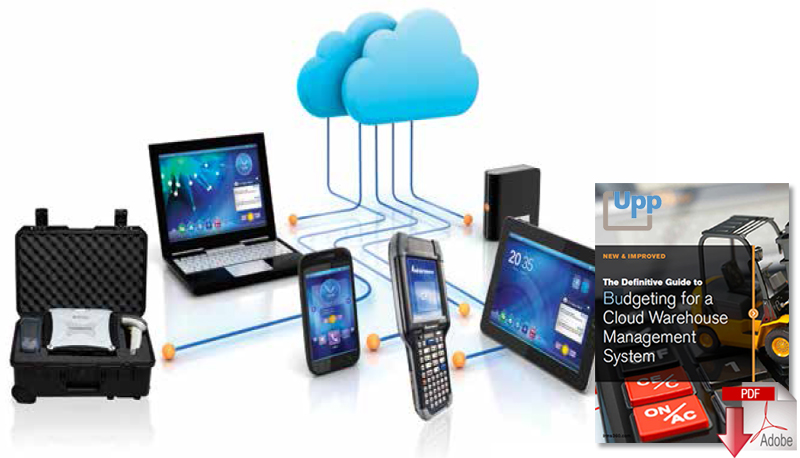5 Tips for a Successful Cloud Warehouse Management System Deployment

Expert recommendations for saving time and money on your cloud warehouse management system implementation.
You have made the decision, you have selected the vendor, and now all that is left is to deploy your new cloud Warehouse Management System.
A piece of cake, right?
Warehouse Management System software implementations are known to be long, complicated, and at times very frustrating.
The pressure of introducing enterprise software into a live environment without disrupting current operations can be massive.
It can take months to fine-tune the off-the-shelf functionality of a WMS to the intricacies of your unique operating environment.
Yes, these implementations are challenging – but the payoff is HUGE.
The ROI of Warehouse Management Systems
When you achieve the perfect harmony between system and operations, inventory accuracy at the bin level soars to 99.999%, driving dramatic cost reductions through your supply chain.
Inventory levels are continuously updated in real-time, warehouse space is put to optimum use, labor productivity rises to all-time highs, and revenue opportunities spring up from everywhere.
However, according to a recent survey, more than 50% of recent supply chain software implementations have failed to deliver a Return on Investment.
“In regards to actual payback, many respondents expressed disappointment with their software implementations. Only 48 percent reported that they had realized the expected payback from a software investment, while 18 percent said they had not. Another 34 percent were uncertain as to whether the software had met the company's expectations for return on investment (ROI).”
ROI is calculated differently for every organization, but users should see a return on their investment between six months and a year from rolling out a new Warehouse Management System.
The reasons for the apparent gap in ROI are likely as varied as each system user. Fortunately, you can reverse the trend for your organization by following some time-tested Best Practices.
5 Proven Tips to Achieving a Quick Return on Your Cloud Warehouse Management System Investment
1. Use the Core Application for 3 Months
Functionally, your Warehouse Management System should be a 90 – 95% fit from the time of purchase.
After all the time spent researching and selecting the right WMS for your organization, the best way to ensure a successful implementation is to trust the system.
Put your new WMS through its paces for 3 months in your environment. After that time, you will have a much better idea of how the software works and whether it supports your operational processes. After observing the system first-hand, you will also have precise insight into any customizations that might be necessary.
Try to resist the urge to create a solution that is just like your previous system. Instead, trust your decision, take your time learning the new WMS, and make customizations where appropriate.
2. Continuously Tweak Business Rules
Legacy warehouse management systems require extensive code rewrites, or customization, to tailor the system to your needs. Such rewrites are costly and can create complex issues when upgrading to new versions of the software.
Cloud platforms, on the other hand, feature intelligent business rules that adapt the application to your operations. Configuring and reconfiguring the software is possible without the time and expense of custom coding.
Your organization’s unique operational processes may be the very thing that sets you apart from competitors. Take advantage of your opportunity to dial-in a cloud WMS and tweak the business rules to your advantage. As your business grows, the continuous configuration of business rules will push your organization to new heights of efficiency.
3. Follow the Proven Implementation Methodology
Warehouse Management System project managers are experts. They are proficient in the system you purchased, in deploying WMS solutions into unique environments, and in supply chain optimization. Therefore, it is in your best interest to follow the steps and phases they have laid out in the project plan.
Quality project plans from WMS experts already include your timeline and goals, and provide room for change. Give these plans a chance to work. This established approach is designed to keep the long-term focus on a successful deployment with minimal influence on your current operations and maximum impact on your future profitability.
4. Build an Integrated Management Team
Perhaps the most important aspect of your Warehouse Management System implementation is your internal team. You need a group of leaders that can make decisions quickly and efficiently. These project champions should include people from across your organization, comprising multiple departments including IT Operations and Finance, with a direct line to the executive suite.
Implementation delays typically stem from an inability to make decisions. Experienced project managers will present many options that will require thoughtful discussion. You need the right people in place to expedite that process. Empowering this group to think judiciously and act quickly is the most important thing you can do to prevent delays and cost overruns.
5. Utilize the Extensive Training Tools
At the end of your implementation, your team will learn how to use the system. The length and depth of training sessions vary with the vendor, but the goal is the same - instruct a few key people in your organization so that they can lead the rest when the project manager is gone.
While leadership training is essential, it is equally important to recognize that the “Train-the-Trainer” approach is not the end of your organization’s WMS education. Traditionally, vendors might just hand over huge system manuals on their way out the door, but most vendors now embrace a continuous training environment.
Users have different learning styles and what works for one user may not work for another. Nowadays, training opportunities may include long-form video tutorials, task-based quick guides, detailed user guides, and system tutorial podcasts. Multiple forms of learning provide users with choice, clarity, repetition, and reinforcement. All the better to making you and your team WMS experts.
Related Article: The Cloud Demands a New ROI Formula
Budgeting for a Cloud Warehouse Management System

Article Topics
Upp Technology News & Resources
5 Tips for a Successful Cloud Warehouse Management System Deployment The Cloud Demands a New ROI Formula Budgeting for a Cloud Warehouse Management System Cloud-Based Solutions Are Augmenting TMSLatest in Warehouse|DC
Microsoft Unveils New AI Innovations For Warehouses Spotlight Startup: Cart.com is Reimagining Logistics Walmart and Swisslog Expand Partnership with New Texas Facility Taking Stock of Today’s Robotics Market and What the Future Holds U.S. Manufacturing Gains Momentum After Another Strong Month Biden Gives Samsung $6.4 Billion For Texas Semiconductor Plants Walmart Unleashes Autonomous Lift Trucks at Four High-Tech DCs More Warehouse|DC














